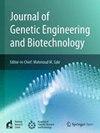Virtual screening and identification of potent phytoconstituents from Acorus calamus L. as inhibitors of Monkeypox virus infection
IF 2.8
Q3 Biochemistry, Genetics and Molecular Biology
Journal of Genetic Engineering and Biotechnology
Pub Date : 2025-04-25
DOI:10.1016/j.jgeb.2025.100487
引用次数: 0
Abstract
Background
The threat posed by the Monkeypox (Mpox) disease has re-emerged globally while the world strives to recover from the Corona Virus Disease −19 (COVID-19) pandemic. The World Health Organization has declared Mpox a global health emergency. Monkeypox virus (MPXV), the causative agent of Mpox disease, is a zoonotic, large, enveloped, double-stranded deoxyribonucleic acid (DNA) virus that belongs to the Orthopoxviridae genus. The Food and Drug Administration (FDA), USA has approved repurposed antiviral agents Cidofovir and Tecovirimat as the primary treatment options for Mpox, however, they project systemic toxicity and have underwhelming clinical data. A plethora of medicinal plant compounds including flavonoids, phenolics, terpenoids, and alkaloids have a wide range of biological activities such as antimicrobial, antioxidant, antiulcer, antineoplastic, anti-inflammatory, and immuno-stimulating potentials. Since many of them are being studied in modern research to discover an active drug candidate, we turned to medicinal plants to explore potent antiviral compounds.
Methods
In the present study, we aimed to screen phytoconstituents of Acorus calamus L. (AC) against four essential virulence enabling proteins D8L, A48R, D13L, and A42R of MPXV by in silico approach. Further, we have elucidated pharmaceutical-relevant parameters of hit compounds through their absorption, distribution, metabolism, excretion, and toxicity (ADMET) properties as well as drug-likeness parameters.
Results
Our results revealed that AC phytoconstituents such as β-Sitosterol against A42R and D8L, Lucenin-2 against D13L and Zingiberene against A48R showed the strongest binding affinities, respectively. Moreover, Galangin could prominently interact with all four proteins with lower binding energy and higher affinity. All top phytoconstituents obeyed Lipinski’s RO5 and drug-likeness properties.
Conclusions
The phytoconstituents of AC can act as potent inhibitors of essential virulence enabling proteins of MPXV. Thus, we recommend further experimental investigations to validate the promising results of the present in silico study.
菖蒲有效植物成分猴痘病毒感染抑制剂的虚拟筛选和鉴定
在全世界努力从2019冠状病毒病(COVID-19)大流行中恢复的同时,猴痘病构成的威胁在全球再次出现。世界卫生组织宣布麻疹为全球卫生紧急情况。猴痘病毒(MPXV)是猴痘病的病原体,是一种人畜共患的大包膜双链脱氧核糖核酸(DNA)病毒,属于正痘病毒属。美国食品和药物管理局(FDA)已经批准了重新用途的抗病毒药物Cidofovir和Tecovirimat作为Mpox的主要治疗选择,然而,它们显示出全身毒性并且临床数据不令人信服。大量的药用植物化合物,包括黄酮类、酚类、萜类和生物碱,具有广泛的生物活性,如抗菌、抗氧化、抗溃疡、抗肿瘤、抗炎和免疫刺激潜能。由于其中许多正在现代研究中发现一种有效的候选药物,我们转向药用植物来探索有效的抗病毒化合物。方法采用芯片法筛选菖蒲(Acorus calamus L., AC)抗MPXV四种必需毒力蛋白D8L、A48R、D13L和A42R的植物成分。此外,我们还通过hit化合物的吸收、分布、代谢、排泄和毒性(ADMET)特性以及药物相似参数阐明了它们的药物相关参数。结果AC植物成分β-谷甾醇对A42R和D8L、Lucenin-2对D13L、Zingiberene对A48R的结合亲和性最强。高良姜与4种蛋白均有明显的相互作用,具有较低的结合能和较高的亲和力。所有顶级植物成分都符合利平斯基的RO5和药物相似特性。结论AC的植物成分可作为MPXV必需毒力激活蛋白的有效抑制剂。因此,我们建议进一步的实验研究来验证目前在硅研究中的有希望的结果。
本文章由计算机程序翻译,如有差异,请以英文原文为准。
求助全文
约1分钟内获得全文
求助全文
来源期刊

Journal of Genetic Engineering and Biotechnology
Biochemistry, Genetics and Molecular Biology-Biotechnology
CiteScore
5.70
自引率
5.70%
发文量
159
审稿时长
16 weeks
期刊介绍:
Journal of genetic engineering and biotechnology is devoted to rapid publication of full-length research papers that leads to significant contribution in advancing knowledge in genetic engineering and biotechnology and provide novel perspectives in this research area. JGEB includes all major themes related to genetic engineering and recombinant DNA. The area of interest of JGEB includes but not restricted to: •Plant genetics •Animal genetics •Bacterial enzymes •Agricultural Biotechnology, •Biochemistry, •Biophysics, •Bioinformatics, •Environmental Biotechnology, •Industrial Biotechnology, •Microbial biotechnology, •Medical Biotechnology, •Bioenergy, Biosafety, •Biosecurity, •Bioethics, •GMOS, •Genomic, •Proteomic JGEB accepts
 求助内容:
求助内容: 应助结果提醒方式:
应助结果提醒方式:


